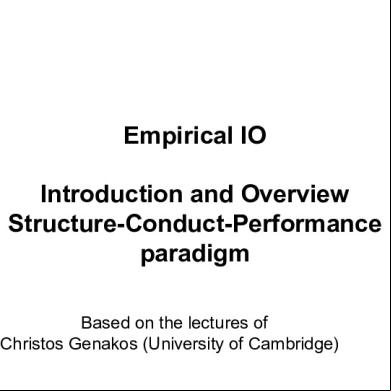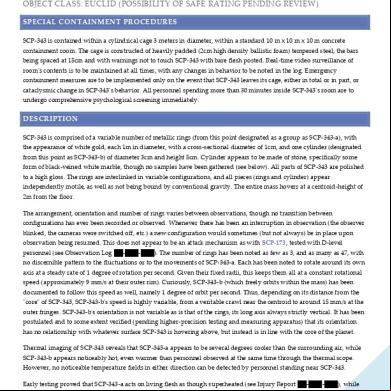About Scu And S 26t39
This document was ed by and they confirmed that they have the permission to share it. If you are author or own the copyright of this book, please report to us by using this report form. Report 2z6p3t
Overview 5o1f4z
& View About Scu And S as PDF for free.
More details 6z3438
- Words: 468
- Pages: 3
About SCU and S 1
About SCU and S Version 1.0
History Person
Version
Testing Date
Abdolreza
1.0
2007-03-16
About SCU and S 2
A brief definition about what is SCU and what are S and what kind operation can be done on them: Roles: Service Class (SCU) and Service Class Provider Perhaps no part of the DICOM terminology is more confusing than the Service Class and Service Class Provider. If you will think of DICOM as a client/server model, think of the SCU as the client and the S as the server. The SCU (or client) requests some service from the S (or server). In DICOM, however, the roles S and SCU refer to the specific service being provided at the time and not to the overall architecture. A DICOM entity commonly acts in several service class roles either as or as provider, and often in both. The SOP class defines the actions of the SCU and the S. Let’s examine briefly how the SCU and S interact in each service class.
Verification Service Class S/SCU Roles The Verification Service Class is simply a means of determining whether a DICOM entity is active and can be reached on the network. The SCU requests this verification and the S, if active, provides a response. No other data is exchanged.
Storage Service Class S/SCU Roles Each of the Storage SOP Classes handle only one particular image (or other object) type. The use of the term “Storage” is perhaps unfortunate. “Send” would perhaps be a better name. When the SCU requests that an image be stored, it is really only requesting that the S receive the image. The S does not guarantee any duration or safety of storage, but merely accepts the image from the sender. In real life, there usually is some duration of storage implied, possibly even some archiving, but that is up to the manufacturer.
Query/Retrieve Service Class S/SCU Roles The Query/Retrieve Service Class provides two distinct services: Find and move, hence the name Query/Retrieve. In the case of a find request, the SCU requests information (such as patient name, study ID, etc.) about images that the provider has available. The S then responds with any of the requested information that it has.
About SCU and S 3
In the case of a move request, the SCU is asking that certain images be moved from the S to some destination. Although it is typical that the SCU requests the images to be sent from the S back to the SCU (basic retrieve operation), it is also common for the SCU to request that the images be sent to a third entity. Note that the move S must also be an SCU of the Storage Service Class to send the image to the destination.
About SCU and S Version 1.0
History Person
Version
Testing Date
Abdolreza
1.0
2007-03-16
About SCU and S 2
A brief definition about what is SCU and what are S and what kind operation can be done on them: Roles: Service Class (SCU) and Service Class Provider Perhaps no part of the DICOM terminology is more confusing than the Service Class and Service Class Provider. If you will think of DICOM as a client/server model, think of the SCU as the client and the S as the server. The SCU (or client) requests some service from the S (or server). In DICOM, however, the roles S and SCU refer to the specific service being provided at the time and not to the overall architecture. A DICOM entity commonly acts in several service class roles either as or as provider, and often in both. The SOP class defines the actions of the SCU and the S. Let’s examine briefly how the SCU and S interact in each service class.
Verification Service Class S/SCU Roles The Verification Service Class is simply a means of determining whether a DICOM entity is active and can be reached on the network. The SCU requests this verification and the S, if active, provides a response. No other data is exchanged.
Storage Service Class S/SCU Roles Each of the Storage SOP Classes handle only one particular image (or other object) type. The use of the term “Storage” is perhaps unfortunate. “Send” would perhaps be a better name. When the SCU requests that an image be stored, it is really only requesting that the S receive the image. The S does not guarantee any duration or safety of storage, but merely accepts the image from the sender. In real life, there usually is some duration of storage implied, possibly even some archiving, but that is up to the manufacturer.
Query/Retrieve Service Class S/SCU Roles The Query/Retrieve Service Class provides two distinct services: Find and move, hence the name Query/Retrieve. In the case of a find request, the SCU requests information (such as patient name, study ID, etc.) about images that the provider has available. The S then responds with any of the requested information that it has.
About SCU and S 3
In the case of a move request, the SCU is asking that certain images be moved from the S to some destination. Although it is typical that the SCU requests the images to be sent from the S back to the SCU (basic retrieve operation), it is also common for the SCU to request that the images be sent to a third entity. Note that the move S must also be an SCU of the Storage Service Class to send the image to the destination.





